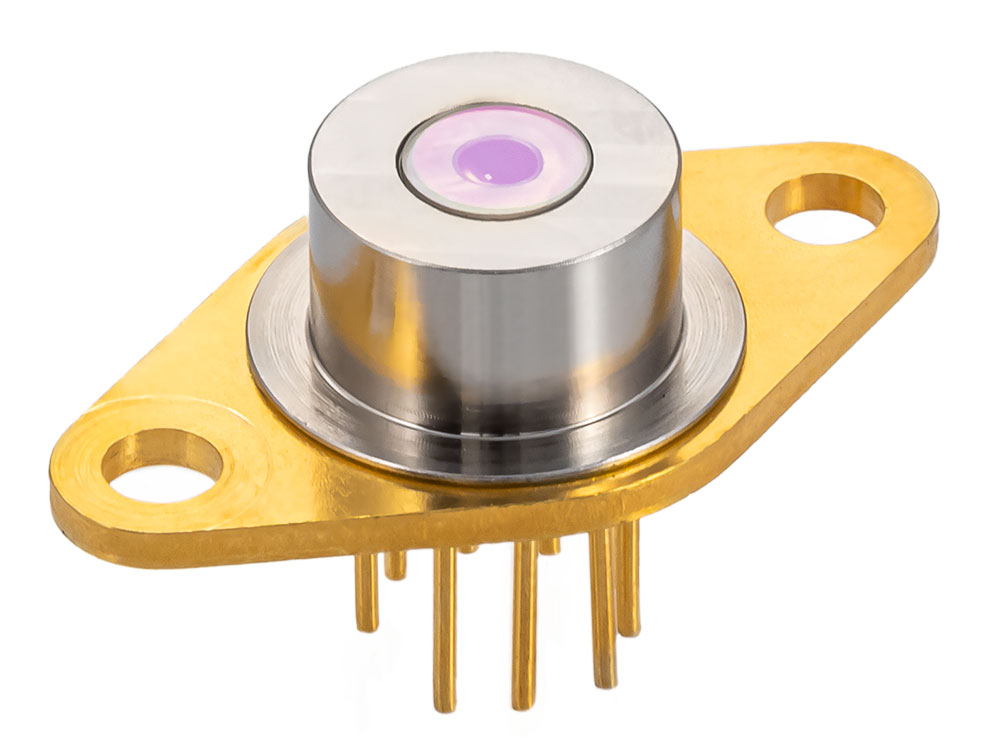

nanoplus offers a DFB interband cascade laser (ICL) at any target wavelength in the mid-infrared (MIR) between 3 μm and 6 μm. The device operates in continuous wave (cw) mode around room temperature. Specifications and behavior are very comparable to a nanoplus laser at lower wavelengths. When you set up an ICL-based analyzer, you can, hence, transfer the engineering knowledge you have gained from building short-wavelength gas sensors.
The nanoplus DFB ICL opens tunable laser absorption spectroscopy (TLAS) for novel MIR applications in industrial gas sensing.
In the 3 μm to 6 μm wavelength window many industrially relevant trace gases have their strongest absorption bands. They show absorption strengths that are several orders of magnitude higher than those in other infrared (IR) areas. This concerns prevalent molecules such as carbon dioxide (CO2), nitric oxide (NO) or water (H2O). Most hydrocarbons, e. g. methane, equally locate their topmost absorbing features at these ICL wavelengths.
Using the strongest absorption band of the detected trace gas contributes to
nanoplus ICLs are considered for various progressive applications in industry and research. In the oil and gas sector, they enable accurate process control and support higher energy efficiency and pollutant reduction.
Compared to other sensing techniques, such as gas chromatography, TDLAS-based sensors offer the unmatched advantage of real-time analysis.
Learn more about the standard specifications of our range of interband cascade lasers.

We have great news for our photoacoustic customers! Our DFB interband cascade lasers at 3345 nm and 4565 nm are now available up to 40 mW. All other specifications remain the same, so you can continue to enjoy the same high-quality performance you have come to expect.

Our DFB Interband Cascade Lasers up to 5500 nm are now available in a fiber-coupled butterfly package with single-mode fiber for easier usability.

NOx is produced during fuel combustion at power plants and other industrial facilities. When it reacts with SO2 it causes acid rain. For this reason NOx and SO2 emissions are restricted and need to be monitored.
[ 67 ]Ethane is a by-product of methane emissions. The ethane ratio varies between methane emissions from thermogenic and biogenic sources. This allows differentiating oil and gas reserves from those of livestock, landfills, wetlands or stagnant water. Studies are executed on behalf of the US Environmental Protection Agency to quantify methane emissions caused byincreased natural gas exploration and production in the US. A newly developed ethane spectrometer delivers 1 second ethane measurements with sub-ppb precision in an ethane-methane mixture.
[ 187 , 61 ]Greenhouse gas effects and climate change have triggered global emission monitoring of pollutants like methane. Methane is one of the Earth’s most important atmospheric gases. It is, to a large extend, responsible for the accelerating greenhouse effect. The global warming potential of methane is about 30 times higher than that of CO2 based on a 100 year scale. Studies are executed on behalf of the US Environmental Protection Agency to quantify the methane emissions caused by the increased natural gas exploration and production in the US.
[ 206 , 198 , 189 , 188 , 187 , 178 , 176 , 162 , 146 , 142 , 141 , 129 , 128 , 119 , 109 , 107 , 92 , 61 ]Ethane is an important greenhouse gas that has a critical impact on climate change. Emissions are related to fossil fuel and biofuel consumption, biomass combustion and natural gas losses. Trace gas detection of ethane is an important tool to monitor greenhouse gases.
[ 187 , 146 , 145 , 128 , 119 , 10 ]Leaks of CH4 may cause dangerous situations and are hard to locate precisely. Hence, maintenance of underground pipelines produces high costs. CH4 leaks are also an important source for greenhouse gases. With TDLAS a strong tool is available to manufacture portable leak detectors.
[ 162 ]Methane content of syngas is controlled to improve combustion efficiency of integrated gasification fuel cell cycles.
[ 35 ]Continuous monitoring of contents like CO2 or CH4 concentrations is essential for the efficiency of high-temperature processes in e. g. incinerators, furnaces or petrochemical refineries. Managing the CO2 content in combustion processes simultaneously reduces greenhouse gas emissions. This is also relevant for energy generating industries like coal burning power plants.
[ 154 , 124 , 121 , 115 , 112 , 111 , 96 , 94 , 62 , 45 , 40 , 35 , 12 ]Different laser technologies have been investigated in recent years to access the 3 μm to 6 μm wavelength range. Besides interband cascade lasers, GaSb-based type I interband diodes and intersubband quantum cascade lasers (QCL) have been a major focus of research.
While GaSb-based type I interband diodes have the disadvantage of decreasing hole confinement and increasing Auger recombination, fast phonon scattering loss impairs the use of intersubband QCLs.
An interband cascade laser, in contrast, uses optical transitions between an electron state in the conduction band and a hole state in the valence band in a cascade of Sb-based type-II QW structures. A broken-gap band edge alignment enables the tailoring of the emission wavelength by altering the cascade structures.
Interband-cascade technology is ideal for high-performance lasing in the entire range from 3 μm to
6 μm due to relatively wavelength-independent threshold powers. It combines high performance with reasonably low power consumption. Like all nanoplus lasers, these devices are manufactured without epitaxial overgrowth, avoiding impairment of ICL performance due to the insertion of patterning-induced defects within the laser layers.
Watch a brief presentation on nanoplus DFB Interband Cascade Lasers (ICL) for Tunable Diode Laser Absorption Spectroscopy (TDLAS)
From the award ceremony at Photonics West 2012, nanoplus accepts the Prism Award in the green photonics and sustainble energy category for their DFB laser at 3 µm. Michael Lebby, GM and CTO of Translucent presented the award.
nanoplus DFB interband cascade lasers (ICLs) won the “Prism Award for Green Photonics and Sustainable Energy” in 2012. They cover the entire wavelength range from 3000 nm to 6000 nm. Many prominent gas species have their strongest absorption features in this window. They are now accessible for tunable diode laser spectroscopy in industry and research. SPIE and Photonics Media honored the laser development in a ceremony during Photonics West in San Francisco.

Do you require further advice? Let us know your needs.